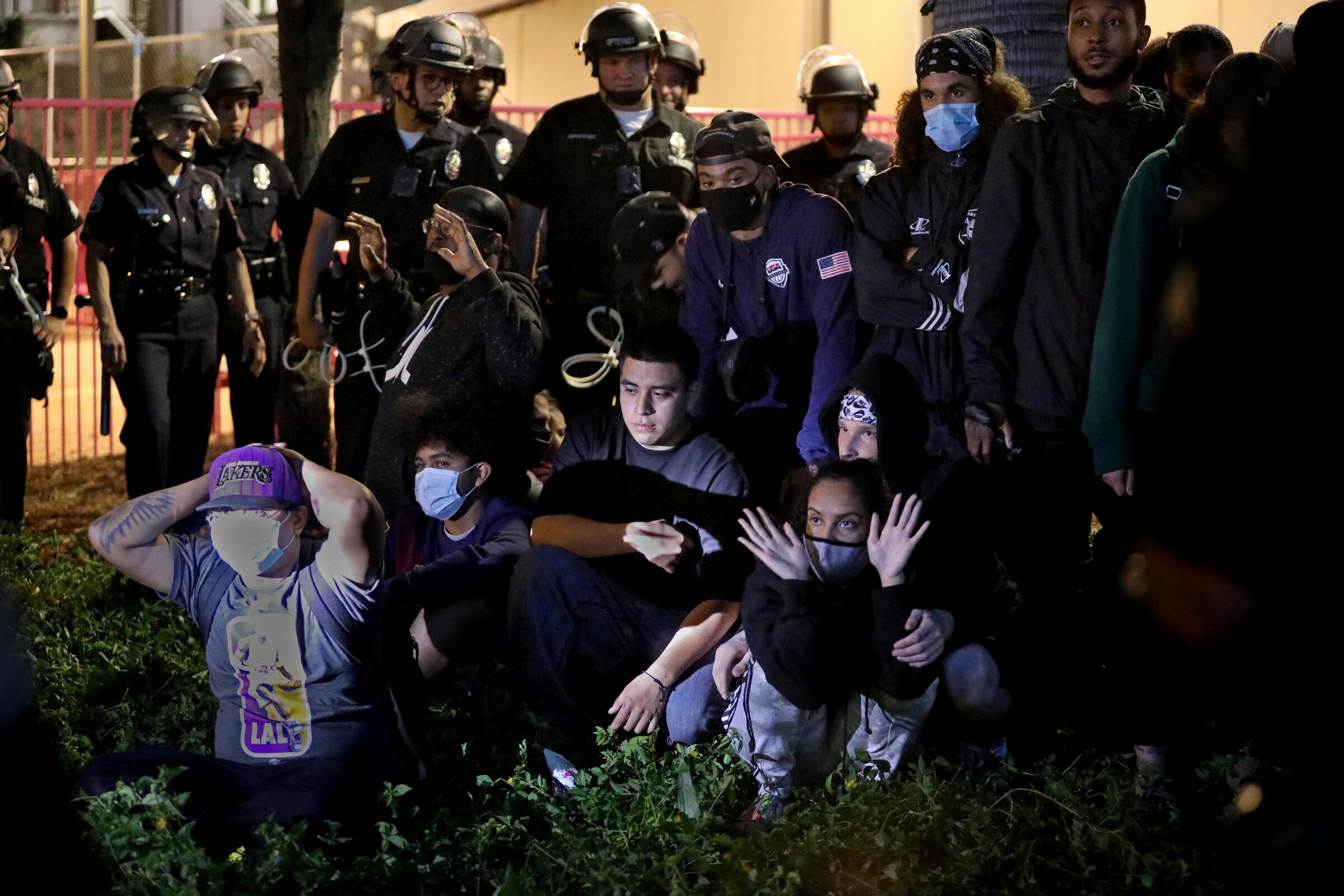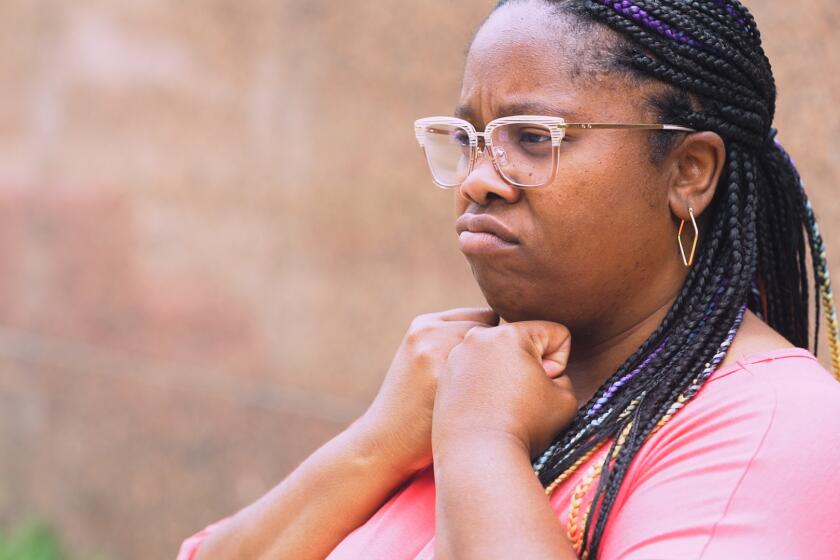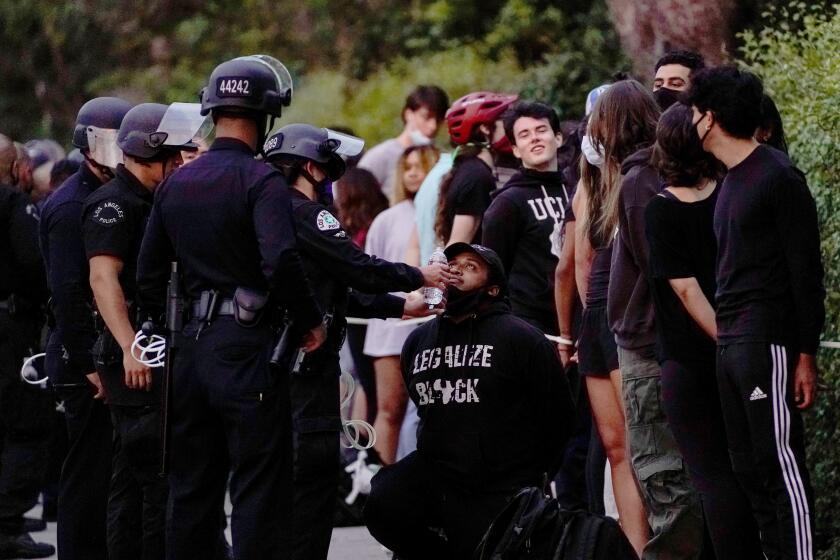The curfew had come half an hour before, and Los Angeles police were screaming for the protesters on 1st and Spring streets to go home.
Amanda Young, 27, said she wanted to leave but realized that she couldn’t.
“Everywhere you turned you saw blue uniforms,” she said. “They sandwiched us in. They were indiscriminately pulling people out of their cars.”
The officers arrested her and 120 others there that night, June 2, for violating the curfew as they protested the death of George Floyd in police custody in Minneapolis.
They zip-tied their hands behind their backs and loaded them onto a sheriff’s bus to be processed at the Metropolitan Detention Center. The police didn’t wear masks, she said, and stood uncomfortably close on the bus, given the COVID-19 pandemic. Her friend had a panic attack.
Young said she spoke to a 14-year-old boy who was clearly upset.
“What am I going to do?” he asked.
For the record:
6:03 p.m. June 9, 2020A previous version of this article said that Amanda Young was arrested along with 120 others on June 1. The arrests were June 2.
They were released two hours later, joining a soon-to-be unprecedented number of people facing misdemeanor charges for staying out past curfew or refusing to disperse.
As protests over Floyd’s killing continued Monday — including car processions led by hearses — Los Angeles County Dist. Atty. Jackie Lacey said her office would not charge any of those arrested in her jurisdiction who were demonstrating peacefully.
“I believe wholeheartedly in free speech and support the right of protesters to demonstrate peacefully against historic racial injustice in our criminal justice system and throughout our nation,” Lacey said in a statement.
Santa Monica’s city attorney took a similar position, and so — to a degree — did Los Angeles City Atty. Mike Feuer, who said he would not seek criminal or financial penalties for any violations that did not involve “violence, looting or vandalism.”
But Feuer added that he would divert them to a program of “dialogue,” a notion that rankled civil rights advocates. Of the 3,000 such arrests countywide, 2,500 fall into his jurisdiction.
Rachel Steinback, an attorney with the National Lawyers Guild of Los Angeles, said anything other than the wholesale dismissal of all curfew cases was unacceptable.
“Our bottom line remains the same. We want no filings, no conditions, period,” she said. “Don’t file. If you’ve already filed, dismiss, and expunge everyone’s arrest records.”
Steinback says her organization, in partnership with the public defenders’ union, has a “veritable army” of defense attorneys who have volunteered to represent anyone who is brought to court on such charges or forced to attend an educational program in exchange for leniency.
“No person who was arrested for exercising their 1st Amendment right to protest should now be compelled to join into a conversation or an educational program with the city or the county,” Steinback said. “That is a violation of their 1st Amendment rights.”
She said black leaders in the city had been asking to engage in a more robust dialogue around police abuses with city and county officials for decades.
“No community member should be obligated to come out now that the city and county are suddenly interested,” she said. “You cannot require someone to engage in a dialogue.”
Carol Sobel, a longtime civil rights attorney who is helping to sue the Police Department over its tactics in recent days, says she is encouraged Feuer isn’t pursuing criminal charges or fines, but Sobel still wants more information about what will be done.
She said Feuer should provide more information to those who were arrested soon, because “a lot of people are concerned, a lot of people were swept up.”
She worries officials won’t go far enough to ease the burdens on people who were unfairly rounded up.
“They want to do the right thing, but they also want to be seen as not being soft on this issue, and I’m not sure that’s the right approach,” she said. “I think in this moment softness would be very welcomed by the community, because it means you’re listening.”
While troubling videos of police violence against protesters have drawn complaints and at least one lawsuit, the experiences of peaceful demonstrators in custody have been less documented. The accounts that emerged in interviews with Los Angeles Times reporters share many elements: police surrounding and arresting people with no notice, sometimes before curfew sounds, ignoring pleas to let them go home, and holding them for up to 12 hours, releasing them miles from their cars or homes in the early-morning hours and telling them to make their own way home.
Laura Montilla, who graduated from USC in public relations last month, said the lights were off inside the police bus as she and 30 or more other female protesters sat in caged sections, their wrists zip-tied behind them so tightly they left cuts and bruises.
They had been arrested at 5th and Main streets in downtown Los Angeles several hours before and had no access to water or bathrooms, Montilla said. Several protesters began to sob and urinate on themselves. Observing a middle-aged woman who appeared to be homeless and in severe mental distress, the protesters cried out for medical attention.
The bus arrived at UCLA’s Jackie Robinson Stadium, 13 miles from where the arrests had been made. An LAPD officer leaned inside and turned on heavy-metal rock music full blast, Montilla said. After 45 minutes of the noise, one of the women started crying and repeating, “This is not OK!”
“It was absolute fear, not knowing where we were or when we would be released,” she said.
Louise Benares, 30, and her partner rode dirt bikes to Fairfax Avenue on May 30 to join protesters and help business owners they knew prevent looting.
The 8 p.m. curfew that night had not arrived, she said, but police blocked protesters, yelling at them to put their hands up. As they were corralled, she said she watched people looting stores and speeding away in cars, unimpeded by officers.
“Most of the people actually detained were members of the protest community and the Fairfax community,” Benares said. “Many protesters were trying to leave, some speaking forcefully.”
She said one asked an officer for his badge number.
“You want my badge number?” he shot back, according to her. “It’s 1, 2 ,3, 4, 5.”
“They raised their weapons; they were taunting us,” she said. “I believe they thought it was funny.”
Among those arrested was a couple on a date at an open-air restaurant and a man coming back from shopping at Whole Foods, Benares said. “I heard him say he was just out of hamburger meat.”
“If we’d been allowed to leave, we would have been home by 8 p.m.,” she said.
Ansis Hoheisel, 27, and Valerie Vega, 28, both of Los Angeles, were surrounded by police on June 2 after curfew in downtown Los Angeles.
“We chanted, ‘Let us go, let us go,’ but they put us in the paddy wagon,” Hoheisel said.
She said she was taken to a parking lot in Panorama City, and Vega was taken to San Pedro.
“They took us to the farthest corners of Los Angeles,” Hoheisel said. “It is a blatant intimidation tactic; they were just trying to get us not to come back out.”
When Vega was released at 12:30 a.m., she said, “they were like: Find your way out.
“There were so many of them standing around the buses, and the choppers circling nonstop overhead,” she said. “That’s why [we have] a goal of taking money out of the police’s hands and put it in other resources. They have too much money.”
Times staff writer Kevin Rector contributed to this report.













